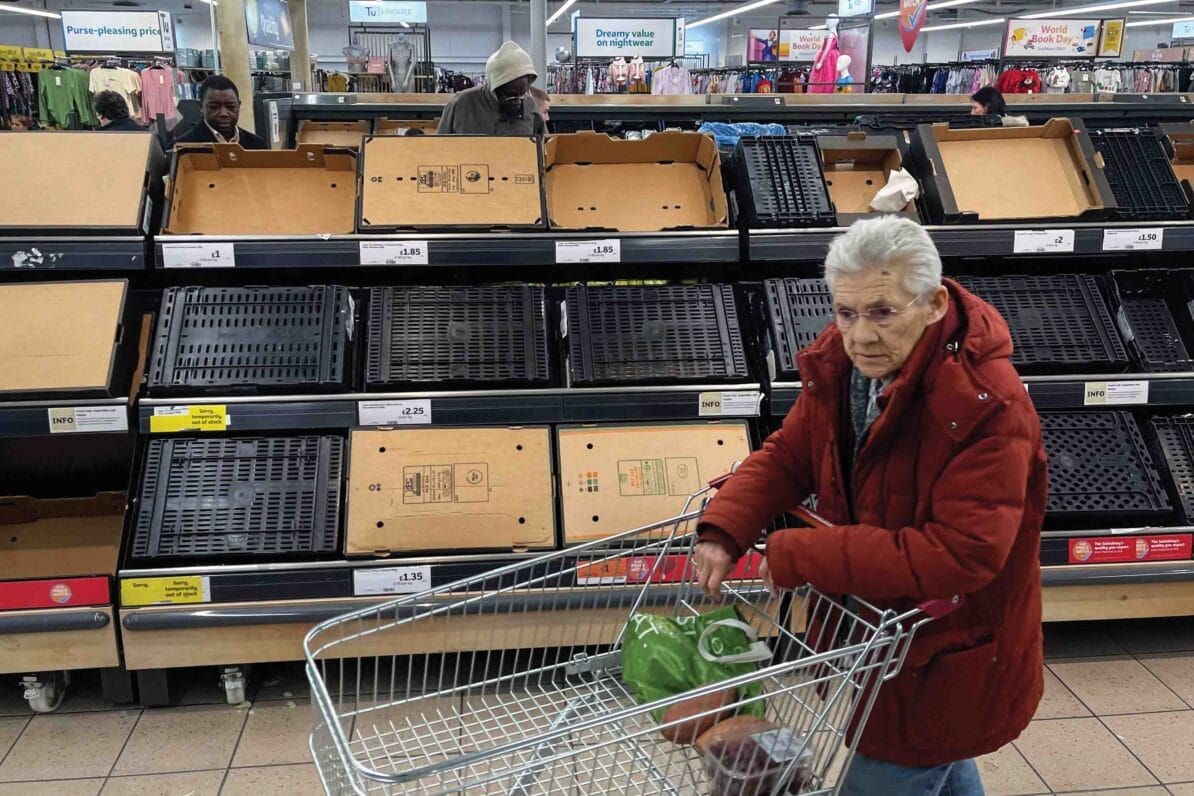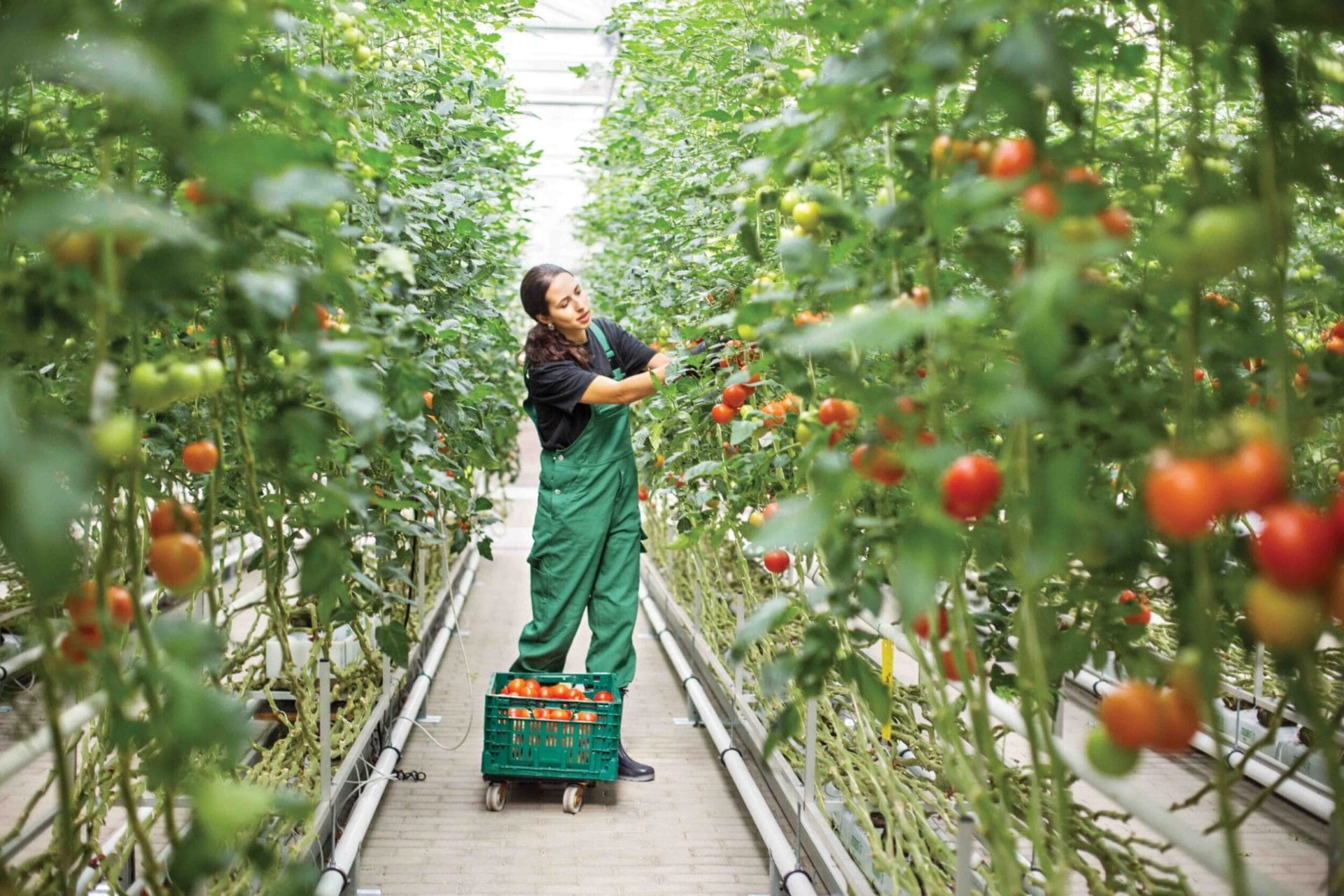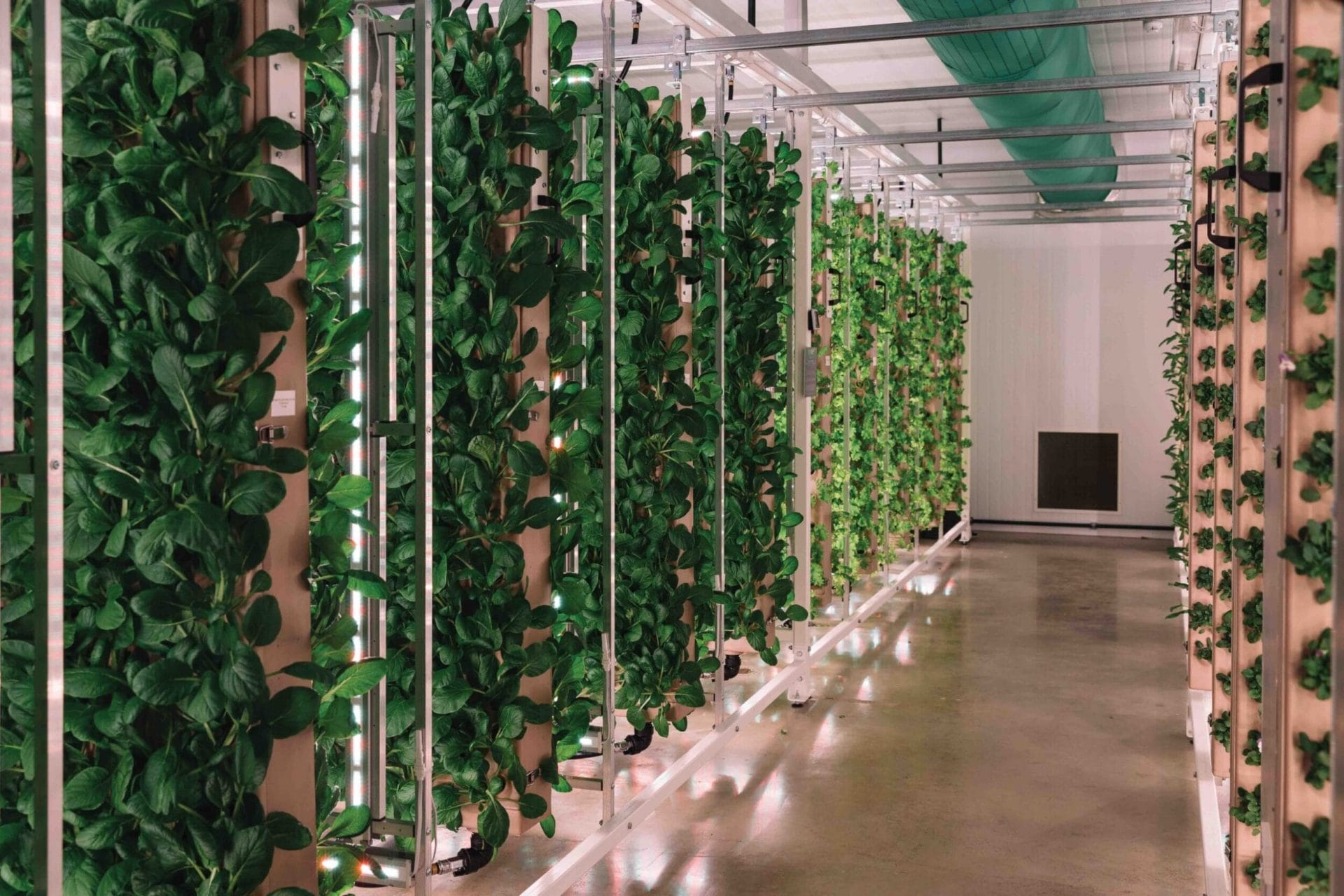A break in the chain
In early 2023, British consumers found themselves faced with empty shelves and fruit and veg rationing at the supermarket, triggered by events 1,000 miles away. We report on a vulnerable and sometimes dysfunctional food chain – and the technology that could help to change it

A customer walks past empty shelves at a supermarket in east London, 24th February 2023. Photo: Daniel Leal/AFP via Getty Images
23rd January 2023 (Taken from: #50)
It began in Spain. On 23rd January, in a story that was understandably little noted in the UK at the time, the Voice of Almeria newspaper remarked that a “polar cold has crossed central Europe and left half of Almería below zero degrees.” The province’s farmers, who run a €3.5 billion industry growing almost four million tonnes of produce each year, including a significant share of the UK’s winter supplies, fought hard against the frost, setting up industrial heaters to boost temperatures in their chilly greenhouses.
It was to no avail: in the weeks that followed their crop yields plummeted, with cucumbers down 50 percent year on year and peppers down 70, with further precipitous drops in tomatoes, raspberries and courgettes. The pattern was repeated across southern Spain. At the same time, across the Strait of Gibraltar, Morocco saw unprecedentedly fierce snow storms in agricultural areas. Suspended boat deliveries caused by turbulent seas and an outbreak of the malevolent brown rugose fruit virus – a fast-spreading blight that leaves tomatoes misshapen and discoloured – combined with the extreme weather to slow Moroccan grocery exports to a trickle.
A month later and a thousand miles away, British supermarket chain Asda introduced rationing on cucumbers, tomatoes, peppers and lettuce amid the Spanish and Moroccan shortages. By 22nd February, draconian veg restrictions were also in place at Morrisons, Tesco and Aldi. In many of their stores, the three-item limit seemed hopelessly aspirational, with fruit and vegetable aisles stocked only with empty crates and apologetic notes. In Birmingham there were reports of a fight breaking out over a grocer’s last box of cucumbers.
The scarcity was reportedly compounded by some British supermarkets’ refusal to alter fixed term contracts and pay more in a time of poor harvests, leading importers to sell their limited produce to other European nations with more flexible purchasing policies instead. As grocery shelves emptied out, Twitter wags joked about installing security measures in their fridges to protect their last remaining tomatoes. On 23rd February, environment secretary Thérèse Coffey caused mirth, outrage and comparisons with both Marie Antoinette and Blackadder character Baldrick for suggesting that UK-grown turnips might prove a viable alternative for Britons hankering after Spanish salad.
“It’s a long time since we were accustomed to purely seasonal fruits and vegetables in this country,” says Martin Emmett, horticulture chair at the National Farmers Union (NFU). “I think it would be extremely difficult for the average consumer to go back to that.” Given that Operation Additional Turnips is unlikely to gain significant public traction, Emmett is clear that “the challenge ahead is dealing with the impact that climate change and the wider economic environment will have on the security of our food supplies.”
“We’ve seen so much consolidation globally in the food supply chain, meaning that there are these concentrated centres of production now,” Emmett continues. This concentration means that events like Spain’s cold snap – and the vicious drought which followed it, featuring the hottest, driest April ever recorded in the country – can throw the food supplies of whole continents off balance. The food chain is not just prone to the lack of rain in Spain, however, but also to the historical obsessions of aggrieved former KGB officers. When Vladimir Putin’s Peter-the-Great complex led him to a vainglorious invasion of Ukraine, a major centre of food production, he instructed the Russian navy to blockade the country’s ports. This temporarily cut the world off from ten percent of its wheat supply, 15 percent of its corn and 47 percent of its sunflower oil.

Greenhouse growers across the UK have suffered from huge increases in their energy costs. Photo: Alvarez
When Moscow drastically reduced its supplies of natural gas to Europe in July 2022 – and later cut them off completely – it led to a big hike in the cost of the fertiliser produced using the fuel. It also exacerbated an energy crisis that led owners of heated greenhouses across the continent to leave crops unplanted in the face of major price increases. Growers in the UK had seen gas prices increase from 46p per therm in December 2020 to £2.77 per therm in December 2022. In Hertfordshire’s Lea Valley, affectionately dubbed the ‘Cucumber Capital of Britain’ by its farmers, a series of operations submitted applications to tear down their glasshouses and use the land for new housing developments, a more reliably profitable crop.
The UK ought to be more than self-sufficient in fruit and veg. We should be getting towards net exporting”
Along with a host of other factors, the effect of energy issues has contributed to a fall in British food production. The NFU says that of the food eaten in the UK, the amount that is actually grown in the country fell from 78 percent in 1984 to 60 percent last year – and is predicted to drop below 50 percent in 2023, leaving the nation’s dinners ever more at the mercy of events abroad.
Despite this worrying recent downwards trend, Emmett remains upbeat about the future. “The UK has this amazingly good competitive advantage of a mild, maritime climate and a good water supply – if we could store [the rain] when it does come,” he says. Energy issues, Emmett believes, can be tackled with “more renewable fuels, biomass boilers, anaerobic digestion systems and a host of new technologies where we can use waste heat sources. We ought to be more than self-sufficient in fruit and vegetables. We really should be getting towards net exporting. Because in the future, given all the climatic advantages that we’ve got in the UK, we’re going to have to play a bigger part in the global food supply.”
To do that, however, the country will need to be able to rely on a large pool of agricultural workers, especially fruit pickers. “One of the worst impacts of Brexit on the agricultural sector was the end of free migration of labour across Europe,” says Emmett. “Labour is a key limiting factor in terms of the potential to expand our production base.”
Availability of labour has not been a problem in Almería, which according to a recent report from British campaigning and research NGO Ethical Consumer provides “one in every six tomatoes eaten in the UK” over winter. The province has relied on low-wage migrant workers from Africa, whose efforts have boosted its growth and productivity and helped its farmers to stay internationally competitive. Agriculture is a labour-intensive pursuit that generates a lot of employment. But in southern Spain it has also created the conditions for human exploitation to flourish.
As you drive south from Valencia towards the Andalusian province of Almería the landscape transforms from verdant citrus groves to a scrubland of muted yellows. After a few hours a desert-like environment takes over and the first plastic-covered greenhouses begin to appear. This is the start of the mar de plastico or ‘plastic sea’, the largest concentration of greenhouses in the world. In 2022, the UK imported €618 million of fruit and vegetables from Almería: British consumption of Almería’s produce is second only to that of Germany, which imports over a billion euros worth of it a year.
Almería is one of Europe’s most arid areas, with just 200 millimetres of rainfall per year (the UK sees over 1,000), but vast oases bloom here under an expanse of polytunnel plastic which stretches on for 32,000 hectares, an area the size of Leeds, Liverpool and Manchester combined.

Aerial view of Roquetas de Mar and the ‘Sea of Plastic’ with its fruit and vegetable greenhouses covering 32,000 hectares. Photo: Hedelin F/Andia/Universal Images Group via Getty Images
It was turned from desert into Europe’s vegetable garden thanks to a Francoist initiative to revitalise the countryside after the Spanish civil war. Between the 1950s and 1970s, the country’s National Institute of Rural Development and Colonisation (INC) offered citizens a ten-hectare plot, along with a house, a horse and a cow, in exchange for part of the profits of the crops they would grow on their new land. To that end, the government built 314 towns across underpopulated areas of Spain, designed and planned by some of the best architects of the time. INC also funded the building of dams, wells and canals to help create fertile ground.
INC’s offer was taken up by 55,000 families, intrepid homesteaders who became known as colonos, or colonists, who cleared rocks under a blazing sun to coax the land into life. The area’s first greenhouse was built in 1963, as an experimental collaboration between the INC and one of the colonos. After some trial and error, they found that customised greenhouses could cut out strong winds, while keeping moisture and temperatures constant around their plants. The widespread introduction of greenhouses in the 1970s led to improved agricultural outcomes in the sandy ground of Almería, and many of the small family farms were consolidated into bigger organisations and entered global food networks.
Colonos today find that newer generations are not as interested as they were in backbreaking work on the land, and it is now mostly migrant workers who have taken up the mantle of tending to Andalusia’s crops. Of Almería’s 52,000 registered agricultural workers, the majority were born outside Spain. Thousands more have settled in the area illegally and work in the greenhouses without contracts or access to government support. Some are treated well – but many are not.
I see dwellings made from materials from greenhouses, resulting in highly flammable structures”
Almería has up to 10,000 migrant workers living in shanty towns. The municipality of Nijar is home to the largest population of them, with 3,500 people residing in precarious asentamientos (settlements) that lack many basic services including running water and rubbish collection. Though migrant workers began arriving to the region in the 1980s and 1990s, recent years have seen an exponential growth in their numbers without a corresponding increase in available housing. An estimated 80 percent of those living in the asentamientos are not registered with the local council at all.
As I walk around the dirt tracks of Atochares, a settlement in Nijar which is home to around 700 people, I see makeshift dwellings made from materials recycled from greenhouses, resulting in poorly insulated structures that are highly flammable. The homes have sprung up next to greenhouses as few workers can afford to own cars and have to walk or bike to their jobs. Drinking water and electricity are scarce. In summer, the temperatures can reach as high as 50 degrees celsius.

Interior of the home of a migrant worker in a settlement in Almería. Photo: Rafael Madero/Europa Press via Getty Images
Residents are fearful to speak with me, and do not want to be identified – as undocumented migrants residing in the country illegally, they live in fear of getting in trouble with the authorities. There are stories of exploitation by employers, including hourly pay far below the minimum wage, unpaid wages and the practice of employers “selling” contracts to employees, sometimes for thousands of euros. Migrants are desperate to obtain contracts which allow them to establish their residency, leading to better, more stable work and protection.
Local NGOs like Almería Acoge (which loosely translates to ‘Almería Welcomes’) have been aiding migrants and working with local councils to find a solution for those living in settlements, the most marginalised of an already vulnerable group. The organisation recently interviewed hundreds of migrants living in settlements to discover more about their living conditions. Persistent themes of racism and of abusive employers emerge from the testimony. One 22-year-old undocumented man from Mali said that “My boss treats me very badly and takes advantage of me. I can’t report him. I’d lose my job if I did, and I don’t want any problems, nor any more misery.”
Many migrant agricultural workers living outside the settlements also experience difficulty in accessing suitable housing. Carolina, originally from Nigeria, has been in Nijar for three of her six years in Spain. “There is a lot of work here, but I have to live in a garage,” she tells me in the town of San Isidro de Nijar. Over her t-shirt, she wears a green smock bearing the logo of the local farm where she works as a picker. “It’s not a good situation. When I was in Valencia, I lived in a proper house, but there was not as much work,” she continues. She says many local landlords refuse to rent to foreigners, or charge above market rates for units that – like her garage – do not even meet the basic housing standards.

Shanty dwellers leave the El Walili camp in Nijar, Almería on 30th January 2023. The settlement caught on fire as its residents were being evicted. Photo: Rafael Gonzalez/Europa Press via Getty Images
According to European Union law, every municipality is obliged to enrol all of its residents, regardless of their immigration status and the state of their dwelling. But local NGOs claim that municipalities refuse to register migrants with addresses listed within the asentamientos. If they’re not registered in the municipality, the council is not responsible for providing any of its services to them. At the end of 2022, Nijar’s council began demolishing settlements, which it says are unsafe and a blight on the area.
One of the largest demolitions took place just as the cold snap was taking hold in Almería. On the morning of 30th January 2023, the 400 residents of the El Walili shanty town were abruptly roused from their beds while the sky was still dark. The local government had long wanted to be rid of El Walili, claiming it wanted to move migrants out of insalubrious conditions and into safe housing. Eviction notices had been sent to the settlement’s residents months earlier, but the authorities arrived unannounced.
As the forced evacuation began, a fire broke out. The flames began licking at the plastic sheeting and black smoke and confusion spread, as people grabbed what they could. Local authorities arrived with fire hoses. As the blaze was tamed and the residents left, the bulldozers moved in to demolish homes that had stood for close to 20 years. Out on the roadside, residents lingered in disbelief as they watched what they’d built with their hands being torn apart. A long line of law enforcement officials stood opposite them, shoulder-to-shoulder, impassively looking on from the middle of the blocked-off road.
Fifty or so residents agreed to be bussed to two warehouses in Los Grillos, located eight kilometres away, where bunks had been set up to receive them, a temporary housing solution supplied by the municipality. Near the warehouses, construction had begun on residences that could house up to 62 people, thanks to funding provided by the regional government.
It is unclear where the other 350 of El Walili’s former residents have gone. It is likely that they have made their way to other settlements such as Atochares, that are not as visible from the main road as El Walili was. But when people are not counted – when they live nowhere – they become invisible. Then all we can see of them for certain are the fruits of their labour.
In its ‘Produce of Exploitation’ report, released in March 2023, British NGO Ethical Consumer lays bare the bleak conditions in Almería, saying that workers there “have faced flagrant abuses of their basic rights” and referencing a 2022 investigation funded by the government of Spain which claims that “the miracle of Spanish food exports would not exist without labour exploitation.” Ethical Consumer states that despite UK supermarkets’ commitments to exploitation-free sourcing and their attempts to enforce it in Spain, many “have failed to take meaningful action, with supply chain policies and enforcement policies only applied to direct suppliers, and voluntary certification schemes and memberships failing to ensure compliance with basic workers’ rights at the farm level.”
In a section on the ‘Root causes of the violations’ in Almería, Ethical Consumer points a finger at the appetites of British consumers. “Over the last 30 years, ways of buying and consuming food in the Global North have drastically changed, favouring more ingredients that cannot be grown in the UK and access to out-of-season fresh fruit and vegetables…” it says. “Supermarkets have helped drive these changes, championing low-cost, year-round supply. Food is considerably cheaper now than it was four decades ago, including for key produce like cucumbers grown in southern Spain – which have fallen in price from £1.44 in 1988 (in today’s money equivalent) to £0.59 in 2019.”
The seasonal workers associated with meeting this demand, it claims, “are particularly vulnerable to exploitation. The transitory nature of the community makes organising or unionising extremely difficult. Workers are unlikely to be able to make demands, due to the short-term nature of their employment.”
We are not playing god. We are just… playing”
But what if there were a way to have all the out-of-season produce without the risk of disruption by freak climate events – and without the exploitation?
In a field in the countryside outside Bracknell in southern England stands a warehouse adorned with the slogan ‘The future of farming’. Inside is a growing room filled with rack upon rack of healthy-looking lettuces, tomatoes, chillis, French beans and assorted brassicas. Tending to them is Felix Trimmer, who can use his phone to administer every facet of the plants’ lives.
“We can control watering regimes, lighting, humidity, CO2, temperature, pH, fertiliser, airflow, everything,” he says. “The system allows us to optimise whatever crop we plug in. We can pretty much design Excel spreadsheets that we can load on the computer and it will run the recipe we give it. Changing parameters and trying things out is easy.” Asked whether he and his colleagues are playing god with vegetables, he pauses to consider. “We are not playing god,” he says. “We are just… playing.”
Trimmer is a plant scientist for IAG, an agritech firm that sells customers everything they need to start their own vertical farms – not just the kit, but also the research data IAG is developing, showing how to squeeze the very best yield and quality out of any given plant. In the company’s base in Bracknell, seeds are nurtured on coconut fibre plugs in a special germination room, featuring large grids of seedlings, marked with their name, batch number and, in one case, the words ‘Felix’s tomatoes, please don’t touch’ neatly written in felt tip.
When the seedlings are ready to be transferred, the coconut plugs are placed into individual slots on the vertical walls of IAG’s proprietary GrowFrame racks, with their roots dangling out of the back. These roots can then be spritzed automatically by aeroponic hoses that give them just the right amount of nutrient-infused mist. All run-off water is collected for redeployment, meaning, says IAG, that the process uses “up to 98 percent less water than conventional farming”.

GrowFrame technology at IAG in Bracknell. Photo: IAG
On the other side of the rack, the leaves and fruit of the plants are bathed in light from LEDs. “We’ve got the lights in special arrangements, with tuneable spectra, so we can really play around, give the plants a little disco,” says Trimmer. “You can actually use light to alter the plant’s metabolism and how it’s reacting. In nature, if a plant is underneath a canopy, the sunlight it receives is going to be quite strong in the far-red light range. So if you want a plant with more branches you give it a lot of far red relative to red and it’ll start branching to obtain more light. However, you’ll reduce the size of the leaves – it’s a balancing act.”
But this vegetable disco doesn’t come for free. Replacing the complimentary rays of the sun with LEDs means that energy is the number one running cost for vertical farms. In the UK, where commercial ventures are not covered by a price cap, electricity costs for businesses increased as much as fivefold between 2020 and 2022. In November 2022 Infarm, previously Europe’s biggest vertical farming company, announced it was laying off half of its workforce due to “escalating energy prices and tough financial markets”.
In order to mitigate some of the increased costs of recent years, IAG has decided to take advantage of cheaper overnight electricity tariffs by convincing the produce it grows that night is day and vice versa. As the sun sets outside the facility, the LEDs inside it are working through a sequence that mimics the temperature and light changes at the breaking of dawn. “It makes no difference to the plants as long as you condition them to it, they don’t care,” says Trimmer. “It’s like if someone was kept awake at night and then allowed to sleep during the day.”
The advantages of growing vertical racks of vampire vegetables are myriad. “Because we control [the environment], we’re not at the mercy of any climate issues or seasonality,” says Kate Brunswick, business development director at IAG. This means that exotic fruits and veg can be grown all year round and that the growing cycle can be accelerated, leading to up to 17 harvests a year for some crops, compared with three or four on traditional farms.
“There’s reduced water consumption and fewer food miles – you’re not flying produce in so you’re taking away that carbon journey – and there are fewer staff required,” Brunswick continues. “We can collect all the data from everything that we grow, so there’s also the sheer level of statistical analysis that’s possible.” The data collected includes the quality of the produce, which is measured partly by machine, and partly via the Flavour Centre at Reading University, “where there are trained teams sitting in little booths, tasting things and pressing buttons and writing down keywords.”
The system’s soil-free status is also a plus. “Soil worldwide is getting trashed with the mass farming that we’re doing,” says Trimmer. “Our indoor farming technology offers the opportunity to move away from relying solely on one form of agriculture. If you can diversify agriculture a bit more it takes pressure off the soil. It’s another string in the bow needed to lessen the impact on the Earth.” The stacking of plants means that land usage is minimised. “This growing room is 135 square metres,” says Trimmer, gesturing around at walls of kale, broccoli, sprouts and dill. “The output is equivalent to about half an acre – 2,000 square metres – of traditional growing space.” This impressive multiplier comes from just one floor in Bracknell, but the aim for most vertical farmers is to build multi-storey facilities that wring enormous yields from minimal space.
You could plug those gaps we had over winter, but we’re not going to plug global hunger with salad”
Such tiered farms could in future be supervised by artificial intelligence. “What I want to do is have an overseer that will look at the crop, with different cameras that can allow you to see in different spectra,” says Trimmer. “You can use these images to see water content in leaves or the pigments that plants produce in response to stress, before the naked eye ever could. You could have a computer watching all these signals, and neural networks interpreting the images and saying ‘There’s a bit of yellowing here in this spectrum on this rack. The plant is stressed. How do we normally respond to that? We add a bit more fertiliser and monitor, monitor, monitor.’” Being able to add hyper-targeted spurts of fertiliser to individual plants in a closed-loop system also means, in contrast to traditional farming, that no chemicals end up running off into local river water.
Despite the issues around energy costs, new vertical farm projects are launching all the time. In February 2023, agritech firm Fischer Farms announced that it had grown a 273 acre wheat yield in a ten acre vertical farm in the UK. Also in February, Dutch company Smartkas launched the UK’s biggest vertical farm in Harlow in Essex, a 27,000 square metre space in which to grow strawberries all year round. Smaller farms are popping up in urban centres, including in a shipping container in Chiswick Business Park in west London and in a former WWII air raid shelter under Clapham High Street.
However Brunswick, who has a family background in traditional farming, urges caution in the face of overly optimistic predictions by some companies. “I think vertical farming has been slightly misbranded in terms of ‘It’s the solution to food security and global hunger’,” she says. “It’s not the answer to everything. It’s the answer to some critical food issues, in specific locations. You wouldn’t grow root vegetables – they’re a very low cash crop and they grow really well in the soil. We’re not going to grow rice, it would take 150 years to get any kind of ROI [return on investment] on it.” The system is best geared, she says, to producing leafy greens and other salad staples, as well as cosmetic and medicinal crops. “I want to train people that vertical farming is part of the story, it’s not the magic wand,” says Brunswick. “You could plug those gaps we had over winter, but we’re not going to plug global hunger with salad.” Trimmer agrees. “I don’t think it’s ever going to take over traditional farming, there’s always going to be a need for truly mass scale for wheat, grass, cereals,” he says. “But for a lot of things, I think it’s probably better to do it in here than it would be to do it outside.”
Microbes can be deployed as biological factories, using vastly less water and land”
Other new agricultural approaches also offer the potential to increase yields and bolster the UK’s homegrown production. The newly-emerging field of precision fermentation involves taking microbes like yeast and inserting a DNA sequence isolated from animals. When the genetically modified microbes are given inputs like hydrogen, sugar, water and carbon dioxide, they excrete things like vitamins, enzymes, animal fats and protein. The microbes can then be cultured in vast numbers, effectively being deployed as biological factories while using vastly less water and land, and producing far fewer greenhouse gas emissions. They also involve no cruelty to animals (although no-one’s asked the microbes for their view). In Australia, Nourish Ingredients is using precision fermentation to make animal fats that “smell and taste as delicious as the real thing.” At the Every company in the US, meanwhile, they’re creating egg whites and albumen protein without the involvement of a single hen.
The shortages that began in February 2023 came to an end after a couple of months, the cucumber rationing was shelved and the grocery aisles brimmed with produce once again. The UK’s sophisticated food supply chain had reasserted itself – but for a brief period its fragility and the contingencies on which its ‘just in time’ model rests had been exposed to public view.
And further blips will continue. In May 2023, the rationing of eggs was briefly reimposed by a series of British supermarkets, amid chronic shortages – driven, among other things, by a major avian flu outbreak and a feed shortage caused by the war in Ukraine. In the hospitality equivalent of the ravens leaving the tower, some Wetherspoons pubs were temporarily forced to ditch eggs from their English breakfasts, replacing them with hash browns and onion rings.
In Almería, the apartments designed to house a small number of the residents evacuated from El Walili had still not been completed as of late May 2023, four months after the fire. The site of the former camp is now a field of rubble, featuring hundreds of cone-shaped piles of dirt created by the bulldozers, a method that makes resettlement of the space nearly impossible.
When it comes to the misery experienced in the sea of plastic and other by-products of the complex food systems on which we rely, there are few simple solutions and many zero sum games. Scaling up vertical farming might plug salad gaps in winter in the UK, but could lead to fewer jobs in places like Almería – which will do nothing to help the migrant workers who fled El Walili to lead less precarious, less exploited lives. Mass-produced microbial proteins might prop up the Wetherspoons breakfast, but could also shift power from local farmers to foreign-owned tech companies. Turning the UK into a net exporter of fruit and vegetables could simultaneously deprive vulnerable developing nations of much-needed foreign income.
For most of us, the intricate web of food logistics will remain largely invisible as it is reshaped in coming years by technology, the market and the environment. Until the next food shortage kicks in, as it surely will. “It just takes one part of the supply chain to slip for a lot of what we expect to be the classic standard of living to drop,” says Trimmer. “Seeing supermarket shelves empty was once almost unfathomable. And yet it will just suddenly happen.”
Slow Journalism in your inbox, plus infographics, offers and more: sign up for the free DG newsletter. Sign me up
Thanks for signing up.








